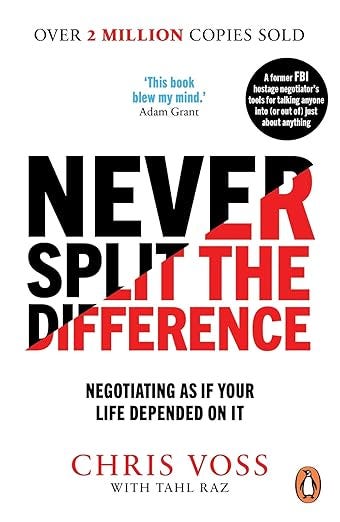A former international hostage negotiator for the FBI offers a new, field-tested approach to high-stakes negotiations—whether in the boardroom or at home. A Wall Street Journal Bestseller. After a stint policing the rough streets of Kansas City, Missouri, Chris Voss joined the FBI, where his career as a hostage negotiator brought him face-to-face with a range of criminals, including bank robbers and terrorists. Reaching the pinnacle of his profession, he became the FBI’s lead international kidnapping negotiator. Never Split the Differencetakes you inside the world of high-stakes negotiations and into Voss’s head, revealing the skills that helped him and his colleagues succeed where it mattered most: saving lives.
In this practical guide, Voss shares nine effective principles—counterintuitive tactics and strategies—you can use to become more persuasive in both your professional and personal life. Life is a series of negotiations you should be prepared for: buying a car, negotiating a salary, buying a home, renegotiating rent, or deliberating with your partner. By taking emotional intelligence and intuition to the next level, Never Split the Difference gives you the competitive edge needed in any discussion.
Here are some key lessons from Never Split the Difference by Chris Voss:
“No” is Not the End—It’s the Beginning: Hearing “No” doesn’t mean rejection; it often means the other person needs more information or feels uncomfortable. Voss explains that “No” is an opportunity to engage deeper and understand their true needs.
Tactical Empathy is Crucial: Understanding and acknowledging the emotions and perspectives of the other party builds trust. Tactical empathy allows you to connect on a human level, making negotiation more productive.
The Power of Mirroring: Repeating the last few words or key phrases the other person says creates rapport and encourages them to elaborate. This subtle technique makes the other party feel heard and opens the door to more meaningful dialogue.
Calibrate Your Questions: Ask open-ended, calibrated questions starting with “What” or “How.” These questions give the other person a sense of control while steering the conversation toward your desired outcome. For example, “How can we solve this issue?” invites collaboration.
Use the Late-Night FM DJ Voice: A calm, slow, and reassuring tone projects confidence and helps de-escalate tense situations. Voss refers to this as the “late-night FM DJ voice,” which encourages the other party to relax and stay engaged.
Labeling Emotions Creates Connection: Identify and acknowledge the emotions the other person is experiencing. Statements like, “It seems like you’re frustrated,” validate their feelings, build rapport, and reduce resistance.
“That’s Right” is Your Goal: Aim to get the other party to say “That’s right” instead of “You’re right.” The former signals alignment and agreement, while the latter can be a polite dismissal. Focus on reframing the conversation to achieve genuine affirmation.
Anchor High (or Low) with Assertive Offers: When it’s your turn to propose terms, start with an assertive offer that anchors the negotiation. This sets the stage for bargaining closer to your preferred outcome.
The Value of Silence: After making a statement or asking a question, embrace silence. People feel compelled to fill the gap, often revealing valuable information or agreeing to your terms.
Always Leave Room for the Other Side to Win: Negotiations are most successful when both sides feel like they’ve gained something. Leave the other party feeling satisfied, even if you’ve achieved your primary goals.











